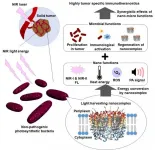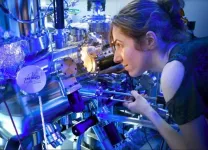Kagome graphene promises exciting properties
2021-02-16
(Press-News.org) For the first time, physicists from the University of Basel have produced a graphene compound consisting of carbon atoms and a small number of nitrogen atoms in a regular grid of hexagons and triangles. This honeycomb-structured "kagome lattice" behaves as a semiconductor and may also have unusual electrical properties. In the future, it could potentially be used in electronic sensors or quantum computers.
Researchers around the world are searching for new synthetic materials with special properties such as superconductivity -- that is, the conduction of electric current without resistance. These new substances are an important step in the development of highly energy-efficient electronics. The starting material is often a single-layer honeycomb structure of carbon atoms (graphene).
Theoretical calculations predict that the compound known as "kagome graphene" should have completely different properties to graphene. Kagome graphene consists of a regular pattern of hexagons and equilateral triangles that surround one another. The name "kagome" comes from Japanese and refers to the old Japanese art of kagome weaving, in which baskets were woven in the aforementioned pattern.
Kagome lattice with new properties
Researchers from the Department of Physics and the Swiss Nanoscience Institute at the University of Basel, working in collaboration with the University of Bern, have now produced and studied kagome graphene for the first time, as they report in the journal Angewandte Chemie. The researchers' measurements have delivered promising results that point to unusual electrical or magnetic properties.
To produce the kagome graphene, the team applied a precursor to a silver substrate by vapor deposition and then heated it to form an organometallic intermediate on the metal surface. Further heating produced kagome graphene, which is made up exclusively of carbon and nitrogen atoms and features the same regular pattern of hexagons and triangles.
Strong interactions between electrons
"We used scanning tunneling and atomic force microscopes to study the structural and electronic properties of the kagome lattice," reports Dr. Rémy Pawlak, first author of the study. With microscopes of this kind, researchers can probe the structural and electrical properties of materials using a tiny tip -- in this case, the tip was terminated with individual carbon monoxide molecules.
In doing so, the researchers observed that electrons of a defined energy, which is selected by applying an electrical voltage, are "trapped" between the triangles that appear in the crystal lattice of kagome graphene. This behavior clearly distinguishes the material from conventional graphene, where electrons are distributed across various energy states in the lattice - in other words, they are delocalized.
"The localization observed in kagome graphene is desirable and precisely what we were looking for," explains Professor Ernst Meyer, who leads the group in which the projects were carried out. "It causes strong interactions between the electrons -- and, in turn, these interactions provide the basis for unusual phenomena, such as conduction without resistance."
Further investigations planned
The analyses also revealed that kagome graphene features semiconducting properties -- in other words, its conducting properties can be switched on or off, as with a transistor. In this way, kagome graphene differs significantly from graphene, whose conductivity cannot be switched on and off as easily.
In subsequent investigations, the team will detach the kagome lattice from its metallic substrate and study its electronic properties further. "The flat band structure identified in the experiments supports the theoretical calculations, which predict that exciting electronic and magnetic phenomena could occur in kagome lattices. In the future, kagome graphene could act as a key building block in sustainable and efficient electronic components," says Ernst Meyer.
INFORMATION:
ELSE PRESS RELEASES FROM THIS DATE:
2021-02-16
Climate change is rapid in the Arctic. As the climate warms, shrubs expand towards higher latitudes and altitudes. Researcher Julia Kemppinen together with her colleagues investigated the impacts of dwarf shrubs on tundra soils in the sub-Arctic Fennoscandia.
The study revealed that the dominance of dwarf shrubs impacts soil microclimate and carbon stocks. Microclimate describes the moisture and temperature conditions close to ground surface. Shrubs are the largest plant life form in the Arctic, and in comparison, to other arctic plants, shrubs use more water and cast more shade.
"The results indicate ...
2021-02-16
WASHINGTON -- When people pause before replying to a question, even for just a few seconds, their answers are perceived to be less sincere and credible than if they had replied immediately, according to research published by the American Psychological Association.
And the longer the hesitation, the less sincere the response appears.
"Evaluating other people's sincerity is a ubiquitous and important part of social interactions," said lead author Ignazio Ziano, PhD, of Grenoble Ecole de Management. "Our research shows that response speed is an important cue on which people base their sincerity inferences."
The research was published in the Journal of Personality and Social Psychology.
Researchers ...
2021-02-16
Cancer is one of the most thought-provoking healthcare problems throughout the world. The development of therapeutic agents with highly selective anti-cancer activities is increasingly attractive due to the lack of tumor selectivity of conventional treatments.
Scientists at Japan Advanced Institute of Science and Technology (JAIST) have created a photosynthetic bacteria-based cancer optotheranostics (Figure 1).
Discovered by Associate Professor Eijiro Miyako and his team from JAIST, natural purple photosynthetic bacteria (PPSB) can play a key role as a highly active cancer immunotheranostics agent that uses the bio-optical-window I and II near-infrared (NIR) light thanks to the light harvesting nanocomplexes in microbial ...
2021-02-16
There is no coat colour that distinguishes dingoes from dingo-dog hybrids, a study involving UNSW Sydney has found.
The Centre for Ecosystem Science research suggests that animals assumed to be dingo-dog hybrids based on their coat colour and culled may have been pure dingoes.
"We actually found pure dingoes that had a brindle, black and tan, patchy or sable coat colour," Dr Kylie Cairns, a conservation biologist from UNSW Sydney and co-author of the study said.
"So that's showing that really dingoes are much more variable than we think and seeing an animal with an odd coat colour doesn't immediately mean that it's a hybrid.
"Using coat colour to decide what animals should be culled is not a very good idea."
The study follows 2019 research by UNSW and collaborators which found ...
2021-02-16
San Antonio, Texas (February 15, 2020) - Researchers at the Southwest National Primate Research Center (SNPRC) at Texas Biomedical Research Institute (Texas Biomed) may have found a new pathway to treat and control tuberculosis (TB), the disease caused by Mycobacterium tuberculosis (Mtb). Using single-cell RNA sequencing (scRNAseq), a next-generation sequencing technology, scientists were able to further define the mechanisms that lead to TB infection and latency. Co-led by Deepak Kaushal, Ph.D., Director of the SNPRC, this is the first study that used scRNAseq to study TB in macaques in depth. Results from the study were published ...
2021-02-16
Scientists of Kemerovo State University, within the framework of the Russian Scientific Foundation grant "Cultivation of isolated cells and organs of rare and endemic medicinal plants of Siberia and the Far East in vitro as a biotechnological method for obtaining biologically active substances", are investigating the fundamental principles of in vitro cultivation of isolated cells and organs of rare medicinal plants - producers of biologically active substances with cytotoxic, antioxidant and antimicrobial properties. One of the urgent problems of medicine and biology is the search and use of plant objects as medicines. The unfavorable environmental situation and the increasing need for medicinal raw materials create its shortage. A new solution ...
2021-02-16
In our ongoing struggle to reduce the usage of fossil fuel, technology to directly convert the world's waste heat into electricity stands out as very promising. Thermoelectric materials, which carry out this energy conversion process, have, thus, recently become the focus of intense research worldwide. Of the various potential candidates applicable at a broad range of temperatures, between 30 and 630 °C, lead telluride (PbTe) offers the best thermoelectric performance. Unfortunately, the outstanding qualities of PbTe are eclipsed by the toxic nature of lead, driving researchers to look into safer thermoelectric semiconductors.
Tin telluride (SnTe) could be an ...
2021-02-16
Ben-Gurion University Researchers Uncover a Catch-22 When It Comes to Social Media Online Support Groups and Privacy Concerns
BEER-SHEVA, Israel...February 16, 2021- People who seek support online social media groups may end up not getting the help they need due to privacy concerns, according to a new study by Ben-Gurion University of the Negev (BGU) and Gutenberg University in Sweden.
The new research, published in END ...
2021-02-16
Could long-distance interactions between individual molecules forge a new way to compute?
Interactions between individual molecules on a metal surface extend for surprisingly large distances - up to several nanometers.
A new study, just published, of the changing shape of electronic states induced by these interactions, has potential future application in the use of molecules as individually addressable units.
For example, in a future computer based on this technology, the state of each individual molecule could be controlled, mirroring binary operation of transistors in current computing.
MEASURING SOCIALLY-DISTANT MOLECULAR INTERACTIONS ON A METAL SURFACE
The Monash-University of Melbourne collaboration studied the electronic properties of ...
2021-02-16
The placement of a wet cotton pellet against Mineral Trioxide Aggregate (MTA) is often recommended to ensure the completion of its setting reaction. This study aimed to evaluate the setting behaviour of MTA Angelus and NeoMTA by comparing their hardness after placing them in dry and moist conditions.
A simulated open apex was created on 40 polyvinyl tubes. The apical 4 mm of the tubes was filled with the two materials, NeoMTA Plus (Avalon Biomed Inc. Bradenton, FL, USA) and MTA Angelus (Angelus, Londrina, PR, Brazil) (n=20 per group). Both groups were subdivided into two subgroups based on the dry and wet conditions (n=10 per group). A wet cotton pellet was placed above the ...
LAST 30 PRESS RELEASES:
[Press-News.org] Kagome graphene promises exciting properties


